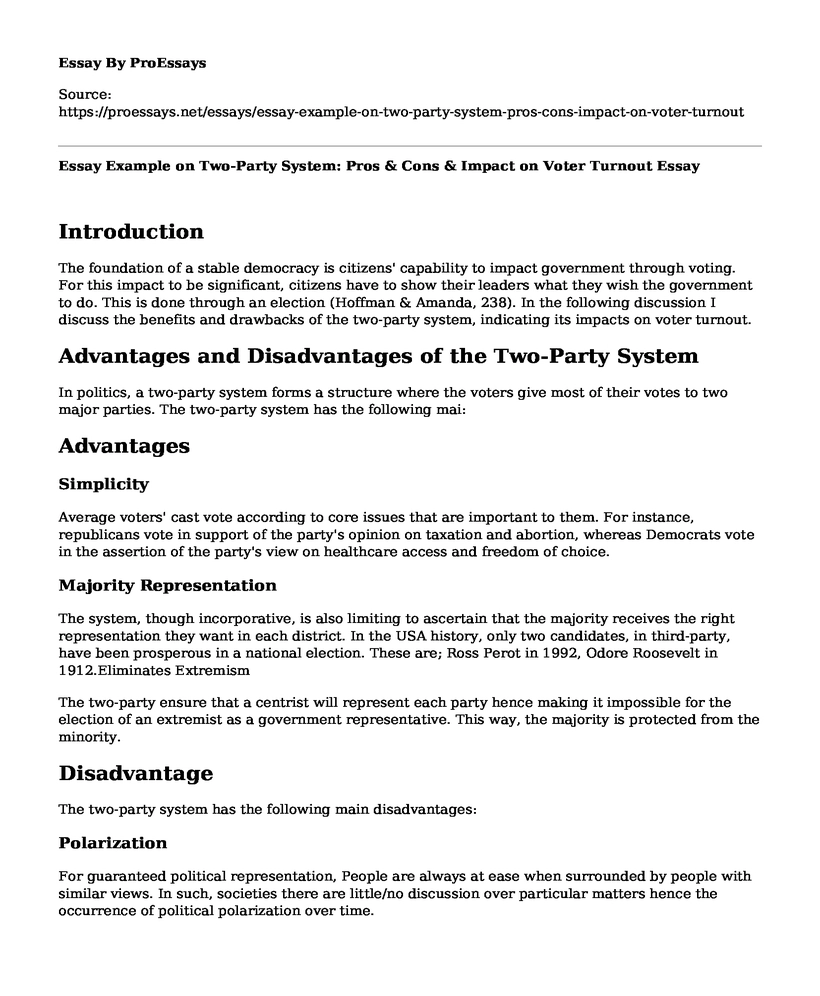Introduction
The foundation of a stable democracy is citizens' capability to impact government through voting. For this impact to be significant, citizens have to show their leaders what they wish the government to do. This is done through an election (Hoffman & Amanda, 238). In the following discussion I discuss the benefits and drawbacks of the two-party system, indicating its impacts on voter turnout.
Advantages and Disadvantages of the Two-Party System
In politics, a two-party system forms a structure where the voters give most of their votes to two major parties. The two-party system has the following mai:
Advantages
Simplicity
Average voters' cast vote according to core issues that are important to them. For instance, republicans vote in support of the party's opinion on taxation and abortion, whereas Democrats vote in the assertion of the party's view on healthcare access and freedom of choice.
Majority Representation
The system, though incorporative, is also limiting to ascertain that the majority receives the right representation they want in each district. In the USA history, only two candidates, in third-party, have been prosperous in a national election. These are; Ross Perot in 1992, Odore Roosevelt in 1912.Eliminates Extremism
The two-party ensure that a centrist will represent each party hence making it impossible for the election of an extremist as a government representative. This way, the majority is protected from the minority.
Disadvantage
The two-party system has the following main disadvantages:
Polarization
For guaranteed political representation, People are always at ease when surrounded by people with similar views. In such, societies there are little/no discussion over particular matters hence the occurrence of political polarization over time.
Thoughtless Voting Patterns
It is common for the electorate to vote based on their political party of choice. Rather than assessing political candidates based on their experience, qualifications, and background, they elect a candidate based on their political affiliations.
Inconsistent Governing
Due to their opposing views on management and implementation of key issues/projects, a winning party reveres policies put in place by the outgoing party. For instance, the Trump Administration attempts to undo the Affordable Care Act, changed the DACA program. This leads to big policy changes making it hard to create required societal change.
Partisanship is defined as how strongly individuals associate with a particular political party (e.g., Democrats or Republicans). Non-partisanship reduces electoral participation and makes it difficult for voters who consistently vote for their political interests. This is because; non-partisanship is affiliated with increased difficulty in decision making. It highly depends on voters' knowledge of the candidate's values, interests, and political ideology, making decision making very difficult ( Bibby & John, 5). Although both advocates and critics of the nonpartisan format offer rational claims to support their positions, the valid evidence on the information voters use is limited and conflicted.
Having more than two parties does not reduce partisanship, because People often affiliate their votes to existing family traditions or positions they had held across many elections. However, having various parties or candidates would increase voter turnout since it improves the representativeness of voters (whether by age, race, or income).
Being a democrat, I am excited since the number of candidates vying for the party's nomination in 2020 is the most and diverse largest in the history of the USA. This means that each candidate has a different view and ideas, therefore, representing various societies (Hoffman & Amanda, 238). What makes it even better is the availability of information on each candidate and platforms such as the recently held debate that would help voters choose the best-suited candidate.
There was a time when America's two-party system was praised for its moderation. No party/ multi-partisanship was viewed to give up on half of the electorate, and it could put forward extremist anti-system candidates ( Bibby & John, 5). Interestingly, this is currently the case with the two-party system, both American parties forsake about half the electorate and endorsing extremists themselves, e.g., Donald Trump. This can be solved by getting rid of the two-party system.
Work Cited
Bibby, John F. Two parties--or more?: the American party system. Routledge, 2019. Retrieved from: https://www.taylorfrancis.com/books/9780429495595
Hoffman, Amanda L. "Political parties, electoral systems and democracy: A crossnational analysis." European Journal of Political Research 44.2 (2005): 231-242. Retrived from: https://ejpr.onlinelibrary.wiley.com/doi/abs/10.1111/j.1475-6765.2005.00225.x
Cite this page
Essay Example on Two-Party System: Pros & Cons & Impact on Voter Turnout. (2023, Feb 27). Retrieved from https://proessays.net/essays/essay-example-on-two-party-system-pros-cons-impact-on-voter-turnout
If you are the original author of this essay and no longer wish to have it published on the ProEssays website, please click below to request its removal:
- Essay on Dangers in Police Realized As They Die In Line of Duty
- Congress Budget and Strategy of the Opioid Epidemic Paper Example
- U.S. Border Policies History Paper Example
- The Congress' Responsiveness to the Mass Public - Essay Sample
- Control in Combating Financial Corruption in Government Agencies: A Saudi Arabian Case Study
- Research Paper on Secure Crowd Control for Convention: Ensuring Public Safety While Protecting Rights
- Essay Example on Annuities Savings: Policymaking, Social Preferences & More







